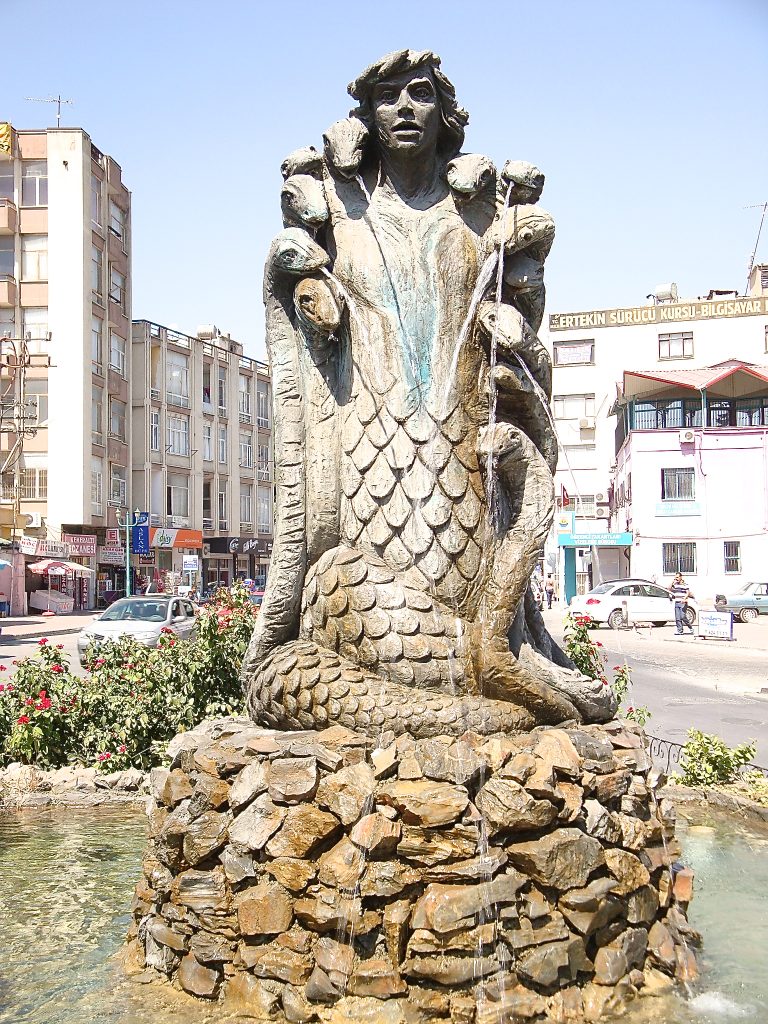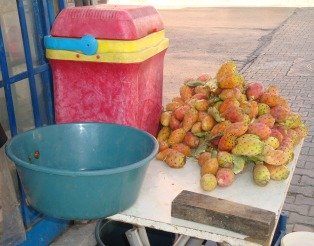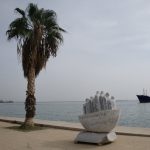Birthplace of St Paul Population: 278,500
Old names: Tarsa, Antiochia ad Cydnum, Juliopolis, Darson/Tarson
Market day: Friday
Favourite son: Saul of Tarsus (St Paul)
At first sight Tarsus, like Mersin, has been swallowed into the Greater Adana conurbation. Turn off the main road, though and you’ll find a pleasant, rather under-rated small town with more than enough attractions to fill a day.
According to the Bible Tarsus was the birthplace of Saul who went on to become Paul after his road-to-Damascus conversion to Christianity. A well in town bears his name whether or not it had anything to do with the man. It stands in a delightful area of restored Ottoman housing, most of it converted into cafes and bars.
Tarsus’ sweaty humidity means lush vegetation – palms, banana plants, rubber plants and bougainvillea. The stone buildings of the back streets with their shuttered windows, heavy corbels and wrought-iron skylights are vaguely reminiscent of Tripoli in Lebanon or Lefkoşa/Lefkosia in Cyprus. The cuisine too has its Levantine twists – a Tarsus-style humus is now very much the rage in upmarket restaurants around the country.
Don’t leave town without:
- sinking your teeth into a piece of cezerye, a carrot-flavoured jelly studded with half walnuts
- enjoying a bowl of warm pastırmalı humus (hummus with pastrami)
- drinking a glass of prickly-pear juice
Around town
 The best starting point for exploring Tarsus is Cleopatra’s Gate, all that remains of the old city wall which was knocked down by the Egyptian leader, İbrahim Paşa, during an invasion in 1835. The gate appears to date back to the second century, so it’s impossible that it could have been standing in its current form when Queen Cleopatra of Egypt is thought to have met Mark Anthony in the city. Unfortunately crude restoration has robbed the gate of much of its erstwhile charm.
The best starting point for exploring Tarsus is Cleopatra’s Gate, all that remains of the old city wall which was knocked down by the Egyptian leader, İbrahim Paşa, during an invasion in 1835. The gate appears to date back to the second century, so it’s impossible that it could have been standing in its current form when Queen Cleopatra of Egypt is thought to have met Mark Anthony in the city. Unfortunately crude restoration has robbed the gate of much of its erstwhile charm.
Turn right at the gate and you’ll soon come to a low hill called Gözlükule (Tower with an Eye), which was the original site of Tarsus. Excavations have revealed settlement dating back to the Early Iron Age although there’s nothing much to see today. Instead the site acts as a green lung for the city centre and a vantage point for looking out over what was once a lake connected to the harbour where Cleopatra landed to meet Anthony in 41 AD.
Close to Gözlükule stand a cluster of venerable school buildings. Most conspicuous is the five-storied warehouse-like Stickler Hall, built in 1910 to house the Tarsus American College and complete with New York-style external fire escape. Nearby stand the Misak-i Milli, the National Pact School, Tarsus’ first primary school, and the plain-faced Sadık Paşa Konağı which accommodates College visitors.
A short walk away, the restored St Paul’s Church was probably built in 1862 with a portico opening onto a hall-like building whose columns have been painted to resemble marble. Aside from the marble screen separating the apse from the nave, there’s little in the way of furnishing. Instead your eyes will be drawn to the frescoes of the four evangelists on the ceiling and to the bucolic paintings that ring the gallery at the back, evoking a rural Cilicia that was a far cry from the industrial sprawl surrounding modern Tarsus.
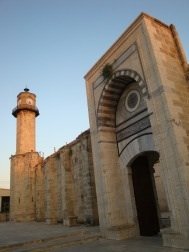 St Paul’s Church is a rather lifeless museum in a building with no meaningful connection with the saint. More impressive is the Ulu Cami which dates back to 1579 and is thought to have been built on the site of an earlier temple and church. It fits into a group with the mosques of Kilis and Diyarbakir that are very Syrian in their design with a long courtyard surrounded by porticos on three sides. Inside, the body of the mosque is also long and narrow with two rows of alternating square and round support pillars – the round ones clearly reuse old Roman columns and capitals.
St Paul’s Church is a rather lifeless museum in a building with no meaningful connection with the saint. More impressive is the Ulu Cami which dates back to 1579 and is thought to have been built on the site of an earlier temple and church. It fits into a group with the mosques of Kilis and Diyarbakir that are very Syrian in their design with a long courtyard surrounded by porticos on three sides. Inside, the body of the mosque is also long and narrow with two rows of alternating square and round support pillars – the round ones clearly reuse old Roman columns and capitals.
A 19th-century clocktower with Arabic numerals stands in for one lost minaret and still chimes the hours. A second stands detached from the building in the garden where more Roman columns can be found. It dates back to 1363 when the Mamluks of Egypt were governing Tarsus.
The Ulu Cami forms part of another cluster of historic buildings. The Kırkkaşık Bedesten (Forty Spoons Market) has already benefited from a facelift and now houses small shops aimed at the tourist market while the Yeni Hamam (New Bath) probably started life in the 16th century and was restored in 1785. It’s still in business today.
Walk in front of the Kubad Paşa Medresesi (1550) and you will come out on Mersin Caddesi, with the austere Makam Cami dating back to 1867 on the left. In Turkish ‘makam’ means the tomb of a saint and it’s believed that the Prophet Daniel was buried here. Restoration of the building and excavation of the surrounding area has been completed although in 2014 there was still no information to explain the structures that have been uncovered and put on display.
In the middle of the road junction is a statue depicting the Şahmaran, the King of the Snakes, a creature, half-human and half-snake. More usually associated with distant Mardin, the Şahmaran is said to have fallen in love with the King of Tarsus’s daughter. Hoping to spy on her at her ablutions, he crept up onto the roof of the old Roman Baths, across the road, but slipped off it, whereupon her bodyguards sliced off his head.
Right beside the remains of the Roman Baths is the Eski Cami, also called the Kilise Cami because it was probably originally built in the ninth or tenth century as an Armenian church dedicated to St Paul. Across the road stands the Eski Hamam (Old Hamam), logically older than the Yeni Hamam, although its precise date of construction is unknown.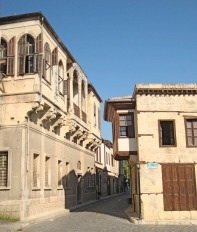
To find Tarsus’s other sights you need to divert behind the Eski Hamam and through an area of old Ottoman housing, much of it newly restored. The finest street is Kemal Tursunbay Sokak which has been restored, recobbled and fitted out with an array of small cafes. There’s a bit of a mismatch between the glamour of the buildings and the smoky, studenty atmosphere inside them. Perhaps the most grown-up is Café Atilla where customers can puff on their nargiles seated on floor cushions at the rear.
 If you stroll along Dr Edip Uğurcan Kürklü Sokak you will come to St Paul’s Well, on a site where St Paul is thought to have lived. Excavations beside the well have uncovered the foundations of walls dating back to the Middle Ages, although nothing older. There’s a small admission fee to approach the well.
If you stroll along Dr Edip Uğurcan Kürklü Sokak you will come to St Paul’s Well, on a site where St Paul is thought to have lived. Excavations beside the well have uncovered the foundations of walls dating back to the Middle Ages, although nothing older. There’s a small admission fee to approach the well.
If you head back in the general direction of Cleopatra’s Gate you will come to Cumhuriyet Alanı where extensive excavations have uncovered a dramatic stretch of basalt-flagstoned Roman road with the remains of a portico running along one side. Alas, there’s no public access.
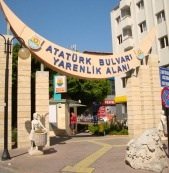 To see the finds from the archaeological sites scattered around Tarsus, walk along pedestrianised Atatürk Bulvarı Yarenlik Alanı (‘Friendly Chatting Place’) which is decorated with busts of all the famous people associated with the town. At the far end of this strip, turn left and head for the new Kültür Evi where the museum houses a multitude of Roman lamps as well as some wonderful felt talismans used by nomads to ward off the evil eye.
To see the finds from the archaeological sites scattered around Tarsus, walk along pedestrianised Atatürk Bulvarı Yarenlik Alanı (‘Friendly Chatting Place’) which is decorated with busts of all the famous people associated with the town. At the far end of this strip, turn left and head for the new Kültür Evi where the museum houses a multitude of Roman lamps as well as some wonderful felt talismans used by nomads to ward off the evil eye.
Other sites are a little further afield.
As the bus from Mersin turns off the main road to approach the centre of Tarsus you’ll see the unexpected sight of a steel-grey Turkish warship sitting right beside the road. This is the Nusrat mine-layer that played a big part in the Gallipoli/Çanakkale Campaign of the First World War. Before the Allied forces attempted to break through the Dardanelles they sent mine-sweepers ahead to ensure safe passage for their ships. But during the night the Turks dispatched the Nusrat to relay the mines, and the following day three Allied ships were blown up. The mine-layer now forms the focal point of Çanakkale Park while Çanakkale itself has to make do with a replica.
At the opposite end of town as the road heads towards the otogar you’ll see a fine old stone bridge over the Berdan river beside the road as well as a tall, spiky war memorial.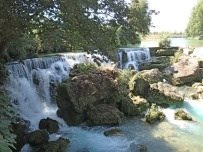
Also on this side of town is a particularly strange monument called the Donuktaş. Reminiscent of the large open-air reservoirs in İstanbul, it is in fact a remnant of a huge 2nd-century Roman temple to Jupiter. The finds are on display in the museum.
A short dolmuş ride from the centre will bring you to Tarsus’ last main sight which is a waterfall (şelale) ringed with tea gardens and restaurants, a great place to stop for an ice cream in the heat.
It’s a 28km round trip to Eshab-ı Kehf, the Islamic shrine built above a cave linked to a story of seven sleepers – but not the same seven sleepers as are associated with Ephesus! The shrine is the centre of an area popular with local picnickers but is not very exciting in itself. Ditto the cave. It’s probably only worth the trip if you are a Muslim.
 Eating
Eating
On the quiet Tarsus has a rather interesting casual eating scene. As in Antakya hummus is very popular here and is sometimes served warm and with pieces of pastırma scattered on the top. Try it at the award-winning Kervan Humus Salonu.
In the great heat and humidity of summer you might like to try cooling down with a glass of prickly pear juice or a bowl of yayla karsambaç, ice with fruit flavouring added to it.
Sleeping
Disappointingly, the old Şelale Hotel is closed. It may have been a concrete eyesore but it did have a great location beside the waterfall.
Elif Hatun Konağı. Tel: 0324-666 0003
Osmanlı Marco Pasha Hotel. Tel: 0324-613 3399
Transport info
The nearest airport is at Adana.
Tarsus is a 45-minute minibus ride from Mersin and about the same from Adana. The frequent minibuses leave from the roundabout around Cleopatra’s Gate.
Frequent trains also run between Mersin and Adana via Tarsus. Cheaper than the buses, they can be standing-room only at peak times.
